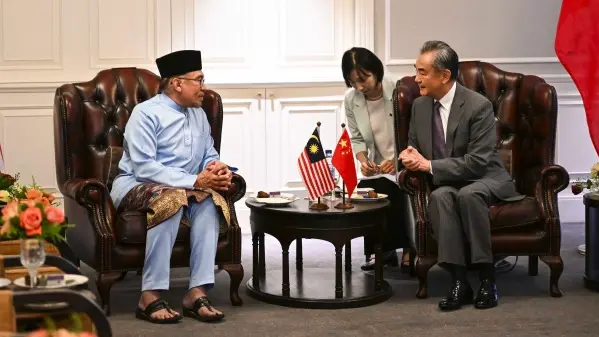Malaysian Prime Minister Anwar Ibrahim met with Chinese Foreign Minister Wang Yi in Penang on August 11, with both sides pledging to deepen bilateral cooperation and strive for more win-win results. Malaysia is the second leg of Wang's three-nation Asian tour, which began in Singapore and also takes him to Cambodia.
Wang Yi's ongoing tour of three Southeast Asian nations underscores China's unwavering commitment to enhancing strategic dialogue in the thriving China-ASEAN partnership. This diplomatic endeavor not only signifies China's resolute dedication to fostering deeper collaboration but also exemplifies its determination to forge enduring bonds with the ASEAN member states.
Through this tour, China exemplifies its role as a steadfast and reliable partner in the region's continued growth and prosperity. Wang's strategic sojourn takes place at a crucial juncture, one where the United States persists in fanning the flames of discord across the Asia-Pacific. As tensions escalate due to Washington's destabilizing maneuvers, Wang's presence accentuates the urgency for unity and interconnectivity within the region. This imperative stems from the need to counteract the divisive machinations perpetrated by the U.S., which have sown seeds of distrust and misunderstanding among nations.
The prevailing sentiment is that any action that jeopardizes the hard-won stability and prosperity of the region will be met with tenacious opposition from countries within. Wang's diplomatic visit thus emerges as a symbol of China's dedication to fostering a harmonious and cohesive Asian landscape, poised to withstand external disruptions. China's diplomatic initiative seeks to fortify strategic ties with its Southeast Asian counterparts, reflecting a renewed impetus in its engagement.
This visit epitomizes China's commitment to translating the fresh facets of its rapport with Singapore into tangible collaborations. China also aspires to forge substantial strides in cultivating a collective destiny with Malaysia and Cambodia, emblematic of harmonious cooperation. This endeavor further intensifies the refinement of Belt and Road Initiative (BRI) cooperation, underscoring China's dedication to a superior standard of engagement. Through these multifaceted efforts, China aims to elevate multilateral relations to a new height, strengthening a platform of shared achievements.
Interestingly, 2023 emerges as a pivotal year, framing significant anniversaries that illuminate China's dynamic regional engagement. This marks the 20th anniversary of China's accession to the Treaty of Amity and Cooperation in Southeast Asia (TAC). Concurrently, a decade has elapsed since the unveiling of the China-proposed 21st Century Maritime Silk Road (MSR), fusing China's destiny with that of ASEAN nations in a cohesive embrace. Amid these milestones, the 10th anniversary of the BRI resonates as a crescendo in China's global vision, epitomizing a collective destiny for humanity. Across Southeast Asia, the BRI has etched pathways of collaboration, poised as a linchpin for China's external equilibrium. Notably, ASEAN nations stand sentinel at this juncture, as custodians of the region's sustainable serenity.
Here, the yearning for enduring prosperity eclipses the specter of discord, knitting together a fabric of shared growth and unity in the Asia-Pacific realm. The symbiotic bond between China and ASEAN grows ever more harmonious, as trade figures for 2023 affirm. With ASEAN as China's foremost trade partner for consecutive three years since 2020, the embrace is deepening further. In the first half of 2023, China's trade with ASEAN countries accounted for 15.3 percent of total trade, reaching 3.08 trillion yuan ($428.96 billion), up 5.4 percent from 2022.
This economic synergy intertwines with the broader narrative. Bolstered by robust economic interlacing, communal interactions, and political discourse, China and ASEAN embolden a narrative of understanding. This concerted effort serves as a countermeasure against the distortions cultivated by external forces, illuminating the path to cohesive growth while sidestepping the pitfalls of discord sown by U.S. intentions.
In the intricate mosaic of China-ASEAN relations, 2023 beckons as a pivotal juncture for elevated interaction. The current year emerges as a fertile epoch for the BRI odyssey. Simultaneously, the landscape is adorned with monumental feats: Jakarta-Bandung's swift glide as ASEAN's inaugural high-speed rail, and Cambodia's inaugural expressway, marking milestones etched in the path of progress. The canvas is adorned with hues of partnership and prosperity.
Wang's voyage is a strategic endeavor, weaving a tapestry of "strategic communication" with Singapore, Malaysia, and Cambodia, anchoring the bedrock of regional equilibrium. China, in harmonious concord, extends its hand to build a platform of economic revival, serenity preservation, and a profound confluence of ideas. Wang has also embarked on a diplomatic mission to forge an accord with Southeast Asian nations on the South China Sea's code of conduct and crisis mitigation. Simultaneously, his endeavor extends to shielding regional economic cohesion from potential U.S. disruptions, enshrining China's role as a guardian of integration and stability.
The voyage symbolizes China's stride in shaping a secure, prosperous framework while weathering the tempestuous waves of external perturbations. Wang's mission encompasses not only strategic alignment but also the cultivation of profound entente through the expansive avenues of the BRI, an ambitious global infrastructure project.
The China-ASEAN comprehensive strategic partnership rides a wave of robust growth. Guided by principles of amity, authenticity, shared gain, and openness, China steadfastly seeks harmonious collaboration. Anchored in the philosophy of nurturing neighborhood friendships and partnerships, China aspires to intensify camaraderie, trust and shared interests with its neighbors.
(CGTN)
 简体中文
简体中文

